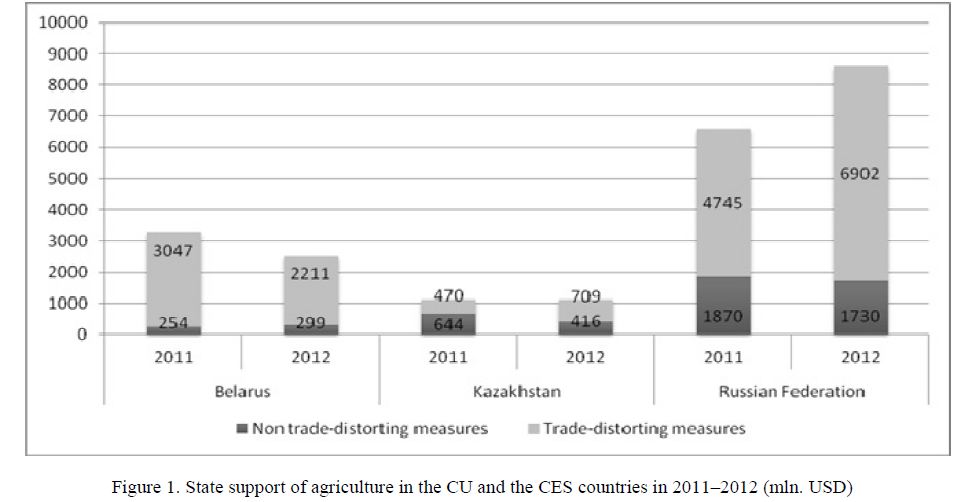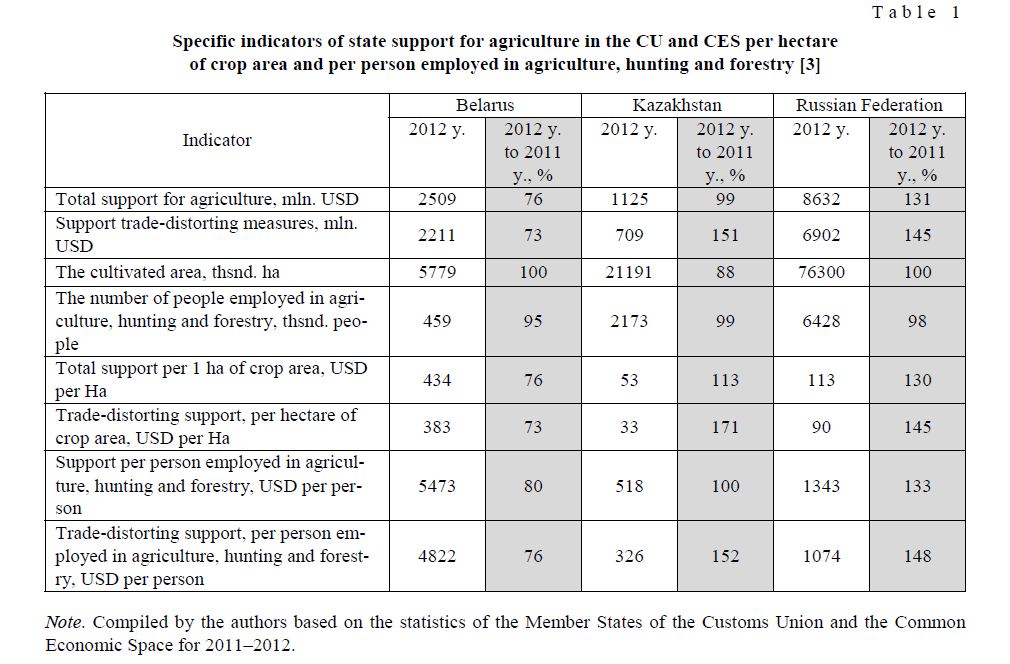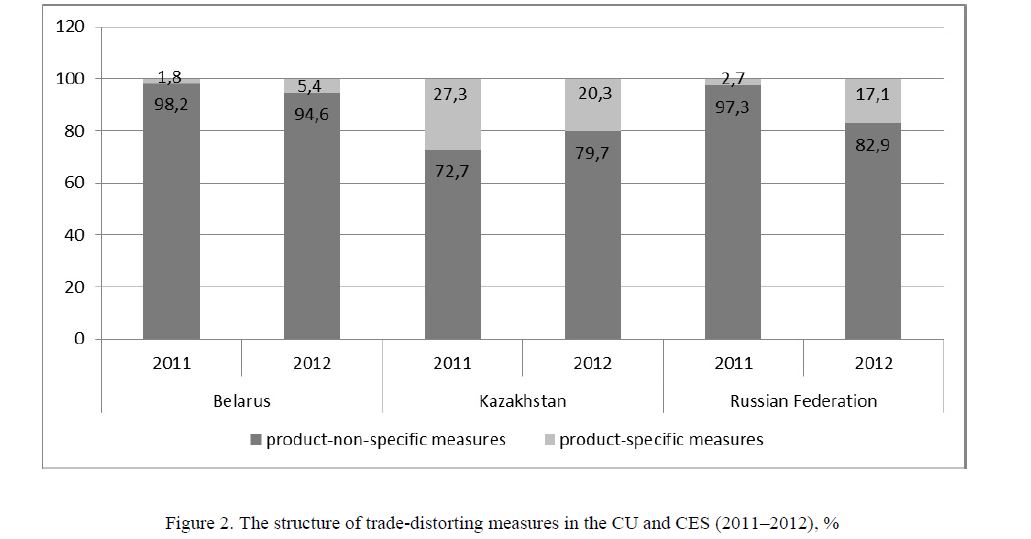The article considering measures of state support for agriculture adopted by Member States of CU and CES depending on the extent of their impact on trade. In view of the prevalence of trade-distorting measures special attention is paid to their structure and effect on trade. Given the urgency of the issue of subsidizing agricultural production analysis of product-specific support for agriculture in the CU and CES was made by authors. The authors conclude on the legality of the absence of intentional distortion of markets as a result of providing measures of state support by the CU and CES countries. Herewith, Kazakhstan is have to increase the amount of their own state support for agriculture, as well as improving its efficiency, which will allow competing with Russian and Belarusian producers taking into account the fact that resolve the amount of state support in the EAEU as planned will not succeed.
мIn accordance with Article 3 of the Agreement on common rules for state support of agriculture dated December 9th, 2010 (hereinafter — the Agreement) government support measures depending on the extent of their impact on trade are particularly divided into three categories:
- non trade-distorting measures;
- trade-distorting measures;
- the most trade-distorting measures [1].
Non trade-distorting measures are not limited. Member States of Customs Union (herein after — CU) and Common Economic Space (herein after — CES) limit the use of trade-distorting measures. The application of the most trade-distorting measures is prohibited [1].
Level trade-distorting measures must not exceed 10 % of the gross value of produced agricultural commodities. A 6-year transition period has the Republic of Belarus. During this period Belarus is committed to gradually reduce the permitted amount of trade-distorting measures from16 % in 2011 to 10 % in 2016. In 2012, the permitted level of support for the Republic of Belarus was 15 %.
In accordance with the Agreement (Article 6, paragraph 3) level of trade-distorting measures for the Russian Federation is set within its obligations in the World Trade Organization (WTO) [1].
WTO membership obligates Russia to reduce the maximum allowable aggregate measure of support*
(AMS) from 9 billion USD (annual mean of AMS for 1993–1995) in 2013 to 4.4 billion USD (AMS annual mean for 2006–2008) in 2018.
In 2012, total support to agriculture measured in dollar terms amounted: 8.6 billion USD (2.0 billion USD more than in 2011) in the Russian Federation, 2.5 billion USD (to 791.0 million USD less than in 2011) in the Republic of Belarus, 1.1 billion USD (8.8 million dollars less than in 2011) in the Republic of Kazakhstan (Figure 1) [2].
* Aggregate measure of support (AMS) – the sum of all types of trade-distorting support provided to agricultural producers and measured in monetary terms. AMS consists of the product-specific AMS (price support and subsidies for the production of certain agricultural commodities: corn, milk, meat, etc.) and product non-specific AMS (support not tied to the production of certain agricultural commodities: the provision of soft loans to agricultural producers, compensation for petroleum products, the establishment of preferential tariffs for electricity consumption, transport of agricultural goods, debt forgiveness for farmers, etc.).

Figure 1. State support of agriculture in the CU and the CES countries in 2011–2012 (mln. USD)
In Belarus, the trade-distorting support decreased by 27.4 % with a significant reduction of total support. In the Republic of Kazakhstan, on the other hand, trade-distorting support has been increased by 50.9 % in 2012. In the Russian Federation, trade-distorting support has been increased by 45 % on the background of a slight reduction of support non trade-distorting.
Specific indicators of state support for agriculture in the CU and CES per hectare of crop area and per person employed in agriculture, hunting and forestry [3]
T a b l e 1

Note. Compiled by the authors based on the statistics of the Member States of the Customs Union and the Common Economic Space for 2011–2012.
The relatively low amount of state trade-distorting support in the Republic of Kazakhstan determined the least specific indicators of such support among the CU and CES countries (Table 1). In 2012, tradedistorting support in the Republic of Kazakhstan per hectare of cultivated area was 33 USD, which is 11.6 times less than in Belarus and 2.7 times less than in the Russian Federation. And per person employed in agriculture — 326 USD, which is 14.8 times less than in Belarus and 3.3 times less than in the Russian Federation.
All countries of the Customs Union and the Common Economic Space provided support for a number of programs. Among the measures non trade-distorting funded: R&D; pest and disease control; dissemination of information, consulting and inspection services. Among the trade-distorting measures implemented: programs of concessional lending; compensation costs for fertilizers, seed, animal feed; support animal and poultry breeding; elite seed production; compensation for participation costs of business entities in the insurance program for crop, livestock, and poultry as well as other product-non-specific measures of state support. In some areas the state support was not implemented. Among the measures non trade-distorting did not provide domestic food assistance to the needy population, direct payments to producers, aid in the insurance programs and income security as well as tools to facilitate structural changes.
Among the trade-distorting measures did not implemented: the acquisition of manufacturers’ assets at prices higher than the market one; debt relief on payments to the budget. Price support in the countries of the Customs Union and the Common Economic Space takes a negative value.
The largest share of trade-distorting measures in the total state support was observed in the Republic of Belarus (Table 2). In 2012, in Belarus the share of such measures in the total state support for agriculture amounted to 88.1 %, which is below the level of 2011 by 4.2 percentage points. In the Russian Federation and the Republic of Kazakhstan, the corresponding figures were 80.0 % and 63.1 %, respectively. Thus, in the countries of the Customs Union and the Common Economic Space bias towards trade-distorting measures is observed [2].
The structure of state support for agriculture in the CU and CES (2011–2012) [4]
T a b l e 2
![The structure of state support for agriculture in the CU and CES (2011–2012) [4]](/uploads/data/files/pics8/3_152.jpg)
Note. Compiled by the authors based on the statistics of the Member States of the Customs Union and the Common Economic Space for 2011–2012.
Among the measures of state support, distorting effect on trade in the CU and the CES in 2012 still prevailed measures of product-unspecific character (Figure 2). In Belarus, the share of such measures in the trade-distorting measures amounted to 94.6 % (down 3.6 percentage points from the index of 2011), in the Republic of Kazakhstan — 79.7 % (an increase of 7.0 percentage points) in the Russian Federation — 82.9 % (down 14.4 percentage points).

Figure 2. The structure of trade-distorting measures in the CU and CES (2011–2012), %
There are differences in the structure of different types of measures of state support for agriculture in the CU and CES (Table 3). In the Russian Federation, among the main measures non trade-distorting dominated services of general and specialized personnel training, pest and diseases control of plants and animals, research funding. The share of these measures accounted for 59.0 % of the amount of support non tradedistorting. The Republic of Belarus is dominated by finance general and special personnel training (38.3 %) and the Republic of Kazakhstan by the pest and diseases control of plants and animals (47.3 %), the creation of state reserves (35.6 %) [4].
The main directions and measures of different types of state support for agriculture in the CU and the CES in 2012 [2]
T a b l e 3
![The main directions and measures of different types of state support for agriculture in the CU and the CES in 2012 [2]](/uploads/data/files/pics8/5_58.jpg)
Among the trade-distorting measures in the Republic of Belarus and the Russian Federation dominated financing costs for servicing loans (respectively 31.8 % and 47.8 % of the funding trade-distorting measures). In Kazakhstan, the bulk of the funds in the framework of support trade-distorting measures are directed to compensate the cost of energy (29.3 %), other support measures / cheaper transport costs on grain exports (21.0 %), subsidies for livestock products (20.3 %).
As part of the trade-distorting product-specific measures of state support in the Russian Federation in 2012 to subsidize the production of flax, cattle, sheep and goat, horse, pig, poultry breeding, reindeer herding, paid subsidies for the production of milk, meat, eggs and wool (Table 4). Belarus subsidized the production of flax and potatoes, beef and dairy cattle. The Republic of Kazakhstan has supported the development of livestock with a focus on poultry production [2].
Product-specific support for agriculture in CU and CES Member States in 2012 [2]
T a b l e 4
![Product-specific support for agriculture in CU and CES Member States in 2012 [2]](/uploads/data/files/pics8/6_38.jpg)
In general, the proportion of product-specific support in the value of production of agricultural goods is low. In 2012, the figure accounted: 0.5 % — in the Republic of Belarus and the Russian Federation in 0.7 % — in the Republic of Kazakhstan. The individual commodity markets are largely distorted by productspecific measures. Markets with a high proportion of product-specific support include:
in the Republic of Belarus — flax market (share of support in the production volume amounted to 83.1 %);
in the Russian Federation — venison (82.8 %) and flax market (31.4 %).
Thereby, the general conclusion about the absence of intentional market distortion as a result of the providing measures of state support by the CU and CES countries is justified.
The most of support measures (distorting and non-trade-distorting) is funded by the federal (republican) budget (Figure 3). In Kazakhstan, the share of expenditures of the republican budget in 2012 was 80.0 %, in the Russian Federation — 72.7 %. A significant part of the state support in the Republic of Belarus (44.0 %) is supplied from the budgets of the administrative-territorial units. In the Republic of Belarus and the Russian Federation, an increase in the share of budget expenditures of administrative-territorial units in the total state support for agriculture has been observed.

Figure 3. Sources of the state support for agriculture in the CU and the CES in 2011–2012 (bln. USD)
The budgets of administrative-territorial units had a small part in financing of measures non tradedistorting, (Table 5). Such measures were fully financed from the national budget in the Republic of Kazakhstan. In the Russian Federation and the Republic of Belarus, the share of budget expenditures of administrative and territorial units for the implementation of measures non trade-distorting respectively amounted to % and 29.0 % in 2012. Thus, the federal and republican budgets dominated in the financing of state support measures non trade-distorting [5].
Budgets of administrative-territorial units occupied approximately the same proportion in the financing of trade-distorting measures: 45.6 % — in the Republic of Belarus -, 31.6 % — in Kazakhstan, 33.5 % — in the Russian Federation.
The share of the federal (republican) budget in the amount of different types of state support for agriculture in the CU and CES in 2012, %
T a b l e 5

Note. Compiled by authors.
The Republic of Kazakhstan is almost entirely at the expense of the republican budget subsidized product-specific measures of state support (measures to livestock support). In the Republic of Belarus and the Russian Federation in the financing of product-specific support measures dominated the budgets of administrative-territorial units.
Thereby, the analysis of the volume and structure of state support for agriculture in the CU and CES shows a tendency of reducing the amount of support, measured in dollar terms, in the Republic of Belarus. In the Republic of Kazakhstan, the volume of total support to agriculture is stable against reduction of measures non trade-distorting. In the Russian Federation support for agriculture is growing up.
Measures distorting are dominated trade in the countries of the Customs Union and the Common Economic Space. The Republic of Belarus is characterized by the highest share of the costs of administrativeterritorial units in the amount of support.
As we know under the Treaty on the Eurasian Economic Union Kazakhstan initiated the development of a new methodology for the calculation of state support for agriculture from January 1, 2016. It is worth noting that Russia as a current member of the World Trade Organization (hereinafter — the WTO), and Kazakhstan as a country aspiring to enter the WTO came to the decision to develop a new methodology based on WTO commitments in amount of funding for the industry. While supported the decision, Belarus entered a reservation according to which it will be guided by a new methodology to 2025. Thus, to resolve the amount of state support in the EAEU as planned will not succeed.
Based on the above it can be concluded that for Kazakhstan way out of this situation is to increase the volume of their own state support for agriculture, as well as improving its efficiency, which will allow competing with Russian and Belarusian producers.
References
- Agreement on common rules of the state support for agriculture dated December 9, 2010 [electronic resource: http://www.eurasiancommission.org/ru/docs/Pages/default.aspx]
- Report on the implementation Agreement on common rules of the state support for agriculture in 2012 by the Member States of CU and CES, [ER]. Access mode: economy.kz
- The concept of agreed (coordinated) agricultural policy states — members of the Customs Union and the Common Economic Electronic resource: [http://www.pravo.by/main.aspx? guid=3871&p0=F91300219]
- Statistical data of the Member States of CU and CES for 2011–2012.
- Decree of the Government of the Republic of Kazakhstan dated February 18, 2013 № 151 «On approval of the Programme for the development of agriculture in the Republic of Kazakhstan for 2013–2020 «Agribusiness–2020».